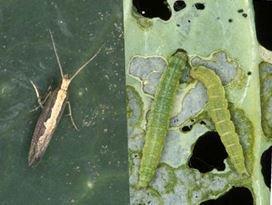
A ‘super pest’ moth resistant to common plant protection products is now also capable of surviving the UK’s cold winter conditions, new research has found.
The pests, which have developed resistance to the pyrethroid class of plant protection products, often have reduced fitness levels and don’t survive through the winter.
However, experts from Rothamsted Research and AHDB are concerned because this does not always appear to be the case with DBM.
Pyrethroid-resistant DBM have been found spending the winter on swede crops grown under insect netting.
And growers are being asked to submit samples of DBM when spotted in winter or spring when numbers start to rise. This will aid the continued monitoring and development of control strategies to manage the pest.
Diamondback moth (DBM) caterpillars feed on crops including cabbage, broccoli, swedes and Brussels sprouts, causing cosmetic damage, which can result in the loss of up to 100 per cent of a crop.
This is of particular concern given that brassicas were worth more than £200m to UK agriculture last year.
Dr Dawn Teverson, knowledge exchange manager at AHDB, said: “This new research reconfirms what we found last year. It’s important that brassica growers are aware of this pyrethroid resistance and plan their crop protection programmes to treat against diamondback moths accordingly.
“If pyrethroids are used, not only does this now fail to control DBM, but it could also kill beneficial insect predators, which would naturally help control the pest, further exacerbating the problem.”
Dr Steve Foster, research entomologist at Rothamsted Research, added: “We have seen in aphids that those which have developed resistance may not survive the winter, however this doesn’t seem to be the case with this new strain of DMB.
“The identification of pyrethroid resistance in this season’s population of moths suggests that they are descendants of 2016’s migrating diamondbacks and therefore that the resistance hasn’t stopped them from surviving over winter.”
The diamondback moth is often described as a 'super-pest' because it has a rapid lifecycle, providing more opportunities for resistance to develop through gene mutation.
In 2016, Foster tested three diamondback moth samples for resistance from Lincolnshire, Suffolk and Scotland. All three samples were resistant to pyrethroids.
Visit the AHDB website for further information about diamondback moth and control options.



